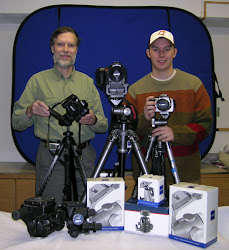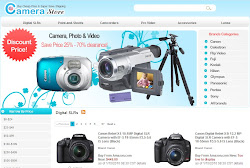Beginning photographers are usually so wrapped up in learning about exposure, depth of field, and creative composition - they tend to overlook the importance of what they are recording the image onto. Whether it be film or a digital sensor - what takes place when the image hits it has a huge determining factor of what it will look like, and most especially will determine how much work you have to do in the darkroom or on the PC.
It should be noted that while I will be mentioning popular film brands, I am not promoting them. I'm not sponsored, nor am I a film sales affiliate. These are the brands I am accustomed to working with. You will need to decide for yourself and hopefully these guidelines will help you.
In my beginning years as a film photographer if you were to dig through my backpack you would find a dozen different film types and way too many rolls per type. "Afterall," I would mutter under the extra weight, "never know what I will encounter!" To a certain extent that is true, but having 10 rolls of 100 ISO color print film of varying brands is a bit extreme!
A simple guideline to follow that you can test for yourself starts with choosing the right ISO rating for the film you work with. As a matter of fact, these ISO principals are the same for digital cameras as well!
Quite simply, the ISO rating is that number on the film box. If you purchased it at the local grocery store it's usually a 200, 400, or 800. That number is the film's rating of how sensitive it is to light. The higher the number the more sensitive - the lower, the less. The mistake many beginning photographers make is the assumption that the higher the number the better because they can shoot in lower light and not use flash, and still use faster shutter speeds. This is fine if you are CSI photographer at a crime scene at night...not so fine if you are shooting a gorgeous landscape with the last of the day's light on the horizon.
Basically - the higher the ISO number the worse the quality of the image - especially if you will enlarge prints. The lower the ISO (particularly where landscapes and nature are concerned) the better the image quality. With print film - color or black & white, when you get up into the 800 and higher range you will see an increase of grain in the printed image. This becomes even more visible as you enlarge the photo. While some artsy photos are quite appealing with this grain, it is extremely unappealing in fine art landscapes or nature. Of course the higher ISO rated films have their place in photography: sports and, well, CSI night photography!
In the 125 ISO or lower range these films are extremely fine grain and generally reproduce fantastic colors! They are excellent for enlargements. Black and white film in this ISO range will have superb contrast and an incredibly smooth tonal range (the transition from white to black).
As a starting point I recommend the following ISO ratings:
50 - 125: Landscapes and scenics
125 - 160: Portraits, people photography where flattering skin reproduction is important
200 or higher: Sports
In case you are wondering, you will not find these high quality films at your local convenience store! You will need to find a camera shop or buy from a professional supplier.
Now, with a general understanding of ISO, this leads to the next part: which film types? For the sake of simplifying education I am focusing on Daylight film, which is usually what you are handed over the counter. But should you shoot with print film or slide film? (also referred to as transparency or chrome film) This will depend on what you are shooting and what will be the end result.
Color Landscapes
Most serious film photographers will agree that slide film in the 100 ISO or lower range is what they work with exclusively. Along with many other photographers, if I am working in color film for landscapes you will only find Fuji Velvia (50 ISO) or Fuji Provia (100 ISO) slide film in my bag. They enlarge prints extremely well, have unsurpassed sharp resolution, and reproduce fantastic shadows and realistic colors. If you have any aspirations of submitting your work to publishers, you will need to learn to work with slide film. Most only accept transparencies or digital files.
The disadvantages with these slide films is they are just that - transparencies. You will have to spend a few more bucks to have prints made from them, and unless you are working with a highly skilled printer the results can be sometimes be disappointing compared to the original transparency. If you want to make a digital file out of it you will need to buy a high end film and transparency scanner. Slide film is also very easy to over expose during the shoot. So until you are accomplished at right-on exposures, you may think I'm an idiot recommending these slide films.
If you are a serious landscape photographer my personal recommendation is to avoid color print films. I switched to the high-end slide films because I never found a color print film that satisfied me. However, I have no doubt there are photographers who have something to say about that.
Black and white landscapes are entirely different. There are many excellent black and white print films available, but after much testing you will only find Ilford PanF (50 ISO) and FP4 (125 ISO) in my film bag. In my bold opinion - black and white print film for landscapes and scenics does not get any better than these.
Portrait and People Photography
Until you become highly skilled with exposure, and you are working with models that have flawless skin - stick to print films. The most important factor with color portrait photography is skin tones. Using films with ISO ratings lower than 160 will bring out the red pigments in a person's skin more than if you stick to the 160 range. Go below 100 and your model will look like they have a nasty rash! I speak from experience.
Kodak makes a wonderful color portrait film called Portra 160. In my opinion it reproduces the most pleasant skin tones and the contrast is perfect. Just as important, it enlarges very well. If you want to try black and white portraits I also recommend giving Ilford FP4 a try. You will see some of the smoothest facial tones imaginable with this film!
One of the advantages with color and black & white print film is the exposure tolerance (or film lattitude) is excellent. This means that if your exposure is just slightly off, the image will still most likely come out looking very nice.
I recommend these as starting points to find what works best for your photography. It is important for you to learn for yourself what works well, and what does not. However, applying these principals will give you a significant step up towards perfecting your photographic work.
Chip Clark is a San Diego based professional photographer, with over 20 years experience in landscape photography, wildlife photography, sports photography, and portraiture.
Chip Clark's photography tutorials are available at http://www.chipclarkphotography.com/advanced-techniques-for-beginning-photographers.htm
Publishing and reprint rights are granted solely according to the guidelines set forth by Ezinearticles.com.
Friends Link : Cheap Handbags4u







0 comments:
Post a Comment